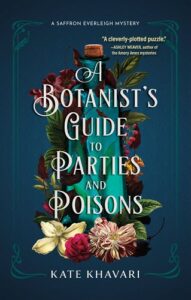What is it about a baffling poisoning that is so—dare I say?— intoxicating?
For me, it’s the mystery of figuring out where the poison came from. Was it something deadly mixed up in a lab, or something pretty growing in a garden? And how does one find out?
Poisoning has long been one of the most popular ways to rid oneself of a person, mostly because there was so little means of proving not only who had done the crime, but that poison was used at all. It wasn’t until the nineteenth century that science began to even the odds between poisoners and those tasked with bringing them to justice.
While I write mainly about botanical poisonings in the Saffron Everleigh Mystery series, first of which is called A Botanist’s Guide to Parties and Poisons, I take a great deal of inspiration from unusual and iconic tales of intentional poisonings, organic and otherwise. Though, it is literary inspiration only, I promise.
An Unhappy Wife
We’ll begin with what might be history’s favorite poison: arsenic. I’ve heard that nearly a third of all poisonings of the mid-1800’s can be attributed to arsenic. It’s symptoms are so general— nausea, gastrointestinal distress, abdominal pain, etc— that they can be easily attributed to any number of other ailments, therefore an ideal poison… had it not been for the trial of a particularly fascinating woman.
1840 saw France and half of Europe riveted by the story of beautiful Marie Lafarge. Her marriage to Charles Lefarge, a successful manufacturer turned out to be a marriage to a bankrupt businessman with a rundown home and demand for exercising his “marital rights.” When Charles began experiencing health problems that led to his eventual death, his family drew the conclusion that his unhappy wife was to blame.
This story was sensational not only because of sympathetic, refined Marie and the relatable, uneven power dynamic between the pair, but because this trial was one of the first to include expert scientific testimony.
The reports of those scientists, however, quickly became contradictory, casting a great shadow of doubt over their analyses. It wasn’t until one of the most well known toxicologists, as we now call them, of the day, Mathieu Orfila, was called upon to offer his expertise that the matter was settled. He declared that, according to his tests, he had found arsenic in the body of Charles Lafarge. Marie was convicted, and one might believe that arsenic started to lose a bit of its shine for would-be poisoners after Orfila proved it could be conclusively diagnosed.
A Misguided Explorer
Juan Ponce de León might have reached the status of one of the world’s most famous explorers for his notable attempt to discover the location of the Fountain of Youth, but to the indigenous Calusa people living in the marshes of south Florida in the early fourteenth century, he was an invader.
Ponce de León had once tried to settle their land “peaceably” without success, and returned nearly a decade later to the region now known as the Florida Everglades determined to conquer the people who had bested him several times before. Unfortunately for him, the Calusa people knew the land much better than he, and used it to their advantage.
In the Everglades, there grows a tree so saturated with a number of toxins that one cannot stand beneath it when it rains without getting burned. Hippomane mancinella, the manchineel tree, is also called manzanilla de la muerte, which in Ponce de León’s native Spanish tongue, translates to little apple of death.
Rather than wait until one of the soldiers stumbled upon the small, toxic green fruits, however, the Calusa warriors attacked them with arrows and spears tipped with the poisonous sap from the manchineel tree. One hit its mark in Ponce de León’s leg. He died weeks later in Havana, likely regretting that his ambition to find life everlasting had only hastened his own death.
The Worst Roommate
Stepping forward in history, we come to the tale of Juwan Royal, a student at a university in Pennsylvania in 2018. His semester started off well enough. He settled into his classes and life on campus with his roommate, Yukai Yang, an international student from China studying chemistry. As time went on, however, discomfiting occurrences began happening.
Headaches battered Juwan, then came dizziness. Shaking and vomiting soon followed. A week after Juwan returned to school from a stay in the hospital, he came back to his dorm room to find hateful racist messages scrawled across his desk. Soon after, Juwan experienced another bout of illness, and, perhaps unnerved by the harassment he’d already been facing, began to suspect that this illness was not a coincidence.
A blood test revealed something shocking: worrying amounts of thallium.
Thallium is a soft metal, odorless and tasteless, and had, astonishingly, been recently purchased by Yukai Yang.
It turned out that the studious chemist with whom Juwan had lived for years, had been slipping thallium into his food, drinks, and even his mouthwash. It all came out when the university’s investigation into the racial vandalism pointed to Yang as the culprit and his computer was seized, where proof of the thallium purchase was discovered. When asked about Juwan’s recent diagnosis, Yang claimed to have bought the poison to commit suicide if his exams didn’t go well, but instead mixed it into the food and drinks he and Juwan shared.
Tragically, Juwan was shocked that his roommate, with whom he’d always gotten along with, had poisoned him.
From the Doctor’s Little Black Bag
Though doctors and scientists were the ones to pave the way for forensic toxicology to develop, the truth is that many of those same doctors had the knowledge and access to dangerous substances. And some took advantage of it.
In spring of 1892 in New York City, the wife of Dr. Robert Buchanan took ill. The doctor treated her hysterical illness with choral, a typical remedy of the time, and she soon subsided, eventually falling into a coma. Dr. Buchanan and other doctor conferred; they decided that Mrs. Buchanan was likely suffering from a cerebral hemorrhage, the same condition that had caused the woman’s father’s death. She died later that evening.
The death was not considered suspicious until Dr. Buchanan did something rather questionable: he returned to his home town, remarried his first wife, and took her to New York City to continue life as usual. Several friends of the original couple kicked up enough of a fuss with the police that Dr. Buchanan was arrested, and, before a year had passed, he was on trial for murder.
The trial uncovered a good deal more than anyone expected. Dr. Buchanan kept his second wife a secret, complained about her looks, and admitted that he only married her for the money. He even was heard to claim that it was easy for a doctor to be rid of anyone he doesn’t want.
Even with such suggestive character evidence, the doctors who testified couldn’t seem to nail down how he’d killed his wife. Morphine poisoning had all the symptoms of what Mrs. Buchanan suffered— except Mrs. Buchanan’s eyes didn’t have the telltale pinprick pupils of someone overexposed to morphine. No one could explain the absence of this key marker, until a man called Macomber took the stand.
He recalled a damning conversation with Dr. Buchanan, in which the doctor theorized that a dose of belladonna extract, famous for making one’s eyes romantically darkened with wide pupils, to the eye counteracts the pin-point pupils produced by morphine. It just to happened that, concurrent to Buchanan’s wife’s death, another man was standing trial for a morphine murder and the victim had been noted to have contracted pupils. Macomber claimed that Dr. Buchanan had learned from that man’s mistake.
This led to a veritable circus of expert witnesses cluttering up the proceedings with contradictory information and colorful laboratory experiments that took place in the courtroom itself. That might have gone on forever, had Rudolph Witthaus not proved with unassailable certainty that it was possible to kill a person in just such a manner. He gave a live cat the same combination of drugs and the court watched the animal die, and then witnessed the unaffected pupils themselves.
It was a grisly conclusion to a grisly case that reminded all who watched it unfold that sometimes the experts can be just as deadly as the poisoners.
***
Featured image: Sophonisba Drinking the Poison
Giovanni Caroto, 1615
















